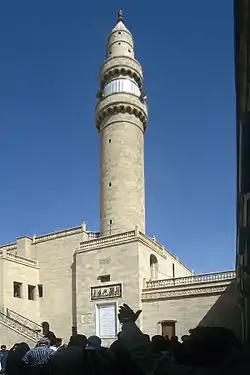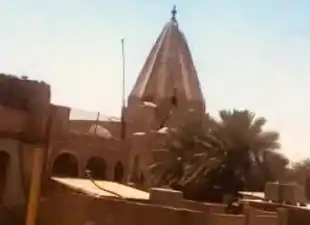This is a list of Islamic sites in the city of Mosul, Nineveh Governorate, Iraq. Islam is the majority religion in Mosul. Muslims of Mosul are predominantly followers of Sunni Islam, with a minority of Shi'ites.

Modern mosques
Mosul Grand Mosque: Situated in the Taqafah district bordering the Tigris river near the Nineveh archeological site. Its construction started during the rule of Saddam Hussein, but just like the Al-Rahman Mosque, the construction was interrupted because of the political instability in the country. The mosque remains incomplete to this day.
Historic mosques and shrines
| Building | Image | District/Quarter | Denomination | First built | Period | Notes |
|---|---|---|---|---|---|---|
| Great Mosque of Al-Nuri |  |
Old City of Mosul | Sunni | 1172–1173 | Zengid | First built by Nur al-Din Zangi in 1172-1173. It is best known for its leaning minaret, known as "Al-Hadba" (the hunchback). The prayer hall was rebuilt in the mid 20th century, between 1940 and 1950. Destroyed in 2017 during the Battle of Mosul and is currently undergoing extensive restorations. |
| Al-Nabi Yunus Mosque |  |
An Nabi Yunus | Sunni | 1365 | Seljuk | Built over an old Assyrian Christian church. It is believe to contain the remains of Jonah. Demolished in 2014 by the Islamic State of Iraq and the Levant. |
| Al-Nabi Jirjis Mosque | Old City of Mosul | Sunni | 1393 | Timurid | Construction was ordered by Tamerlane in 1393. Contains a tomb believed to be that of Saint George. Features two prayer halls for the Shafi'i and Hanafi adherents. Demolished in 2014 by the Islamic State of Iraq and the Levant. | |
| Al-Nabi Shith Mosque | .jpg.webp) |
Ar Rafidayn | Shi'ite | 1815 | Ottoman | Believed to contain the tomb of Seth, son of Adam. Formerly part of a large cemetery and surrounded by mausoleums which are not present anymore. A completely new structure was built between the 1970s to 1980s. Demolished in 2014 by the Islamic State of Iraq and the Levant but undergoing reconstruction. |
| Imam al-Baher Mosque |  |
Mahallat al-Imam al-Bahir | Sunni | 1259 | Zengid | Built in the Zengid era by Badr al-Din Lu'lu. Entombs the remains of Imam al-Bahir, a descendant of Muhammad. Demolished in 2014 by the Islamic State of Iraq and the Levant, but was reconstructed in 2022. |
| Mausoleum of Yahya Abu al-Qasim |  |
Shafaa | Shi'ite | 1239 | Zengid | Built in the Zengid era by Badr al-Din Lu'lu. Entombs the remains of Yahya Abu al-Qasim ibn Hasan, a descendant of Muhammad. Demolished in 2014 by the Islamic State of Iraq and the Levant. |
| Al-Imam Muhsin Mosque |  |
Shafaa | Sunni and Shi'ite | 12th century | Seljuk (mosque and madrasah), Zengid (shrine) | Formerly a mosque and madrasah complex built during the Seljuk era, the madrasah was converted into a shrine for Muhsin ibn Ali by Badr al-Din Lu'lu in the Zengid era. Demolished in 2014 by the Islamic State of Iraq and the Levant. |
| Mausoleum of Imam Awn Al-Din |  |
Bab at-Tub | Shi'ite | 1248 | Zengid | Built by Badr al-Din Lu'lu, the structure survived the Mongol invasions of the 13th century. It entombs the remains of Awn al-Din ibn Hasan. Demolished in 2014 by the Islamic State of Iraq and the Levant.[1][2] |
| Hamu al-Qadu Mosque | Al Midan | Sunni | 1881 | Ottoman | Built in the Ottoman era by Abdullah Chalabi, a wealthy merchant. Contains the tomb of Ala al-Din, who is a descendant of Abdul Qadir al-Jilani. Demolished in 2014 by the Islamic State of Iraq and the Levant.[3][4] | |
| Shrine of Shaykh Fathi al-Mawsili |  |
Bab Sinjar | Sunni | 835 | Seljuk | A religious complex, it includes a mosque as well as the tomb of Al-Fath al-Mawsili, a revered ascetic who lived in Mosul. |
| Building | Image | Location | Denomination | First built | Period | Notes |
|---|---|---|---|---|---|---|
| Sayyidah Zaynab Mosque |  |
Sinjar | Shi'ite | 1239 | Zengid | Built by Badr al-Din Lu'lu, destroyed by the Mongols but later rebuilt in the later Ilkhanid era. Contains the tomb of Zaynab, a daughter of Ali ibn Husayn.[5][6] Demolished in 2014 by the Islamic State of Iraq and the Levant, but restored in 2019.group.[7] |
Castles and fortresses
Qara Saray (Black Palace): Built in the 13th century by Badr al-Din Lu'lu. Damaged during the Mongol invasions via burning.[8]

Other monuments
Tomb of the Girl: A small domed memorial believed to be built over the grave of a female mystic, located in the middle of a street near Bab Sinjar. Historical research proves that it was built over the grave of the historian Ibn al-Athir, which the government has officially stated, with a stele built on the tombstone to indicate his burial there. Bulldozed in 2014 by the Islamic State of Iraq and the Levant.
See also
References
- ↑ "The Shrine of Mashhad al-Imam 'Awn al-Din has been destroyed (Mosul, Iraq, 25th July 2014)". conflict antiquities. 2014-07-28. Retrieved 2022-06-10.
- ↑ راضي, علي محسن (2014-07-24). "داعش الارهابي يفجّر مرقد اً دينياً أثرياً ' وسط الموصل يعود تاريخ بنائه إلى القرن الثاني عشر". وكالة أنباء براثا (in Arabic). Retrieved 2022-06-10.
- ↑ "ISIS destroys beloved mosque in central Mosul". Rudaw.
- ↑ Gianluca Mezzofiore (6 March 2015). "Iraq: Isis destroys 19th century Ottoman mosque in central Mosul". International Business Times UK.
- ↑ "Archnet". www.archnet.org. Retrieved 2022-06-08.
- ↑ "Why an Iran-backed paramilitary group has rebuilt a shrine in a ruined Iraqi city". Atlantic Council. 2019-08-19. Retrieved 2022-06-09.
- ↑ "Why an Iran-backed paramilitary group has rebuilt a shrine in a ruined Iraqi city". Atlantic Council. 2019-08-19. Retrieved 2022-06-09.
- ↑ "قره سراي", ويكيبيديا (in Arabic), 2022-07-08, retrieved 2022-10-24